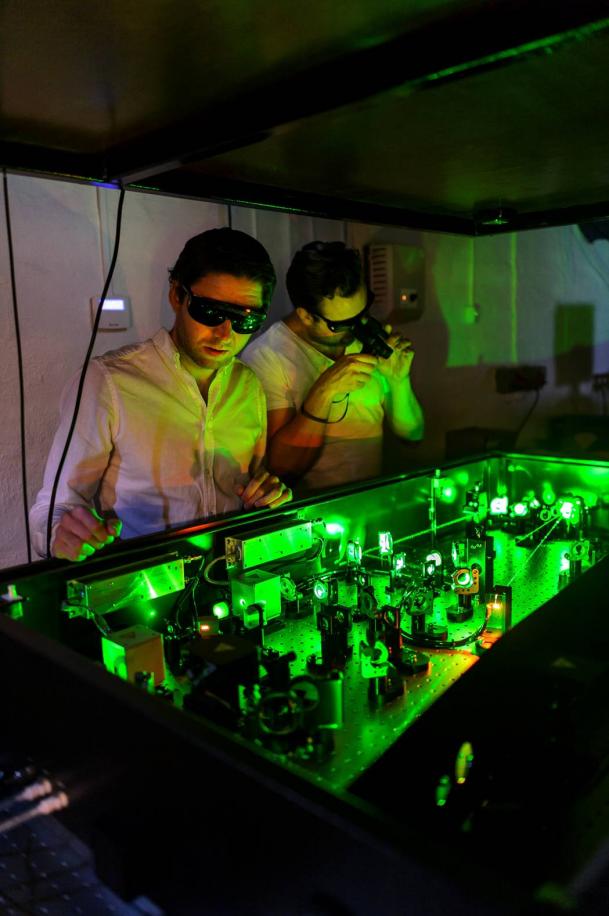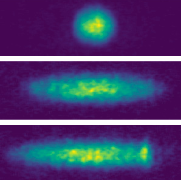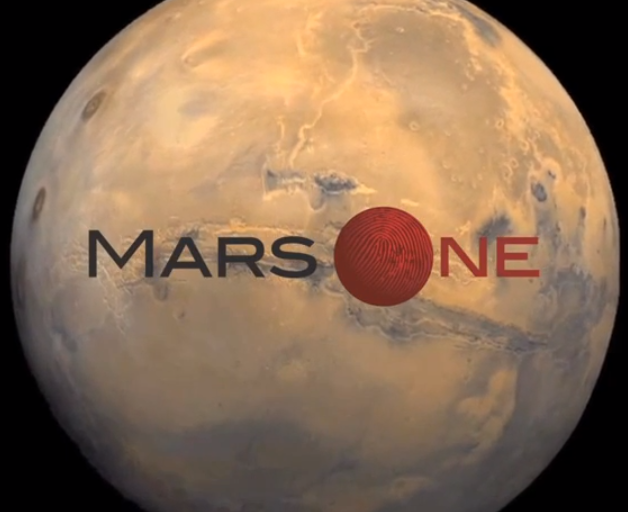In Angry Video Game Nerd episode 214, The Nerd gets a new cell phone and tries out mobile gaming for the first time with My Horse Prince, a dating sim starring an anime girl and a talking horse with an attractive human face!
Julien.champseix
Shared posts
My Horse Prince – Angry Video Game Nerd (AVGN) Episode 214
The world’s fastest video camera

Elias Kristensson and Andreas Ehn (credit: Kennet Ruona)
A research group at Lund University in Sweden has developed a video camera* that can record at a rate equivalent to five trillion images per second, or events as short as 0.2 trillionths of a second. This is far faster than has previously been possible (100,000 images per second).
The new super-fast camera can capture rapid processes in chemistry, physics, biology and biomedicine that so far have not been caught on film.
To illustrate the technology, the researchers have successfully filmed how light travels a distance corresponding to the thickness of paper. In reality, it only takes a picosecond, but the process has been slowed down by a trillion times.
Currently, high-speed cameras capture images one by one in a sequence. The new technology is based on an innovative algorithm, and instead captures several coded images in one picture. It then sorts them into a video sequence afterwards.
Coded flashes
The method involves exposing what you are recording (for example a chemical reaction) to light in the form of laser flashes, where each light pulse is given a unique code. The object reflects the light flashes, which merge into the single photograph. They are subsequently separated by detecting the keys.
The camera is initially intended to be used by researchers who literally want to gain better insight into many of the extremely rapid processes that occur in nature. Many take place on a picosecond and femtosecond scale.
“This does not apply to all processes in nature, but quite a few, for example, explosions, plasma flashes, turbulent combustion, brain activity in animals and chemical reactions. We are now able to ‘film’ such extremely short processes”, says professor Elias Kristensson. “In the long term, the technology can also be used by industry and others.”
“Today, the only way to visualize such rapid events is to photograph still images of the process. You then have to attempt to repeat identical experiments to provide several still images which can later be edited into a movie. The problem with this approach is that it is highly unlikely that a process will be identical if you repeat the experiment”, he says.
The researchers are currently conducting research on combustion — an area known to be difficult and complicated to study. The ultimate purpose of this basic research is to make next-generation car engines, gas turbines, and boilers cleaner and more fuel-efficient. Combustion is controlled by a number of ultra-fast processes at the molecular level, which can now be captured.
For example, the researchers will study the chemistry of plasma discharges, the lifetime of quantum states in combustion environments and in biological tissue, as well as how chemical reactions are initiated.
The research has been published in the journal Light: Science and Applications. A German company has already developed a prototype of the technology, which should be available commercially in two years.
* The technology, named FRAME (Frequency Recognition Algorithm for Multiple Exposures), uses a camera with a flash, using “coded” light flashes, as a form of encryption. Every time a coded light flash hits the object — for example, a chemical reaction in a burning flame — the object emits an image signal (response) with the exact same coding. The following light flashes all have different codes, and the image signals are captured in one single photograph. These coded image signals are subsequently separated using an encryption key on a computer.
‘Negative mass’ created at Washington State University

Experimental images of an expanding spin-orbit superfluid Bose-Einstein condensate at different expansion times (credit: M. A. Khamehchi et al./Physical Review Letters)
Washington State University (WSU) physicists have created a fluid with “negative mass,” which means that if you push it, it accelerates toward you instead of away, in apparent violation of Newton’s laws.
The phenomenon can be used to explore some of the more challenging concepts of the cosmos, said Michael Forbes, PhD, a WSU assistant professor of physics and astronomy and an affiliate assistant professor at the University of Washington. The research appeared Monday (April 17, 2017) in the journal Physical Review Letters.
How to create negative mass
The researchers created the conditions for negative mass by cooling about 10,000 rubidium atoms to just above absolute zero, creating a Bose-Einstein condensate (in which individual atoms move as one object). In this state, particles move extremely slowly and, following the principles of quantum mechanics, behave like waves. They also synchronize and move in unison as a “superfluid” that flows without losing energy.
The lasers trapped the atoms as if they were in a bowl measuring less than a hundred micrometers across. At this point, the rubidium superfluid has regular mass. Breaking the bowl will allow the rubidium to rush out, expanding as the rubidium in the center pushes outward.
To create negative mass, the researchers applied a second set of lasers that kicked the atoms back and forth and changed the way they spin. Now when the rubidium rushes out fast enough, if behaves as if it has negative mass.
The technique used by the WSU researchers avoids some of the underlying defects encountered in previous attempts to create negative mass. It could hold clues to the behavior occurring in the heart of ultracold neutron stars, which also act as superfluids, and cosmological phenomena like black holes and dark energy, said Forbes.
The work was supported in part by a WSU New Faculty Seed Grant and the National Science Foundation.
Abstract of Negative-Mass Hydrodynamics in a Spin-Orbit–Coupled Bose-Einstein Condensate
A negative effective mass can be realized in quantum systems by engineering the dispersion relation. A powerful method is provided by spin-orbit coupling, which is currently at the center of intense research efforts. Here we measure an expanding spin-orbit coupled Bose-Einstein condensate whose dispersion features a region of negative effective mass. We observe a range of dynamical phenomena, including the breaking of parity and of Galilean covariance, dynamical instabilities, and self-trapping. The experimental findings are reproduced by a single-band Gross-Pitaevskii simulation, demonstrating that the emerging features—shock waves, soliton trains, self-trapping, etc.—originate from a modified dispersion. Our work also sheds new light on related phenomena in optical lattices, where the underlying periodic structure often complicates their interpretation.
VERY BEST WISHES FOR 2014
Well, it would be an understatement to say it’s been a busy year.
It seems each project is barely done when the next is clamouring to be undertaken. Everyone involved in the Hobbit worked very long hours to get it finished. There is still another one to go, and that will be it for the extended wanderings in Middle-Earth. After that, it will be back to more illustrative pursuits – in an ideal world, I hope to lock myself away in the studio and just write and paint.
Apologies as well for not being more present on the site forum over the last year. Special thanks, as always, to Dom for troubleshooting, and to Graeme for moderating. Months seemed to speed by at an unprecedented cadence, and long days at Weta Digital left little time to contribute and participate. (Most evenings, my brain had turned to mush anyway.) As well, I’ve been writing a good deal, and preparing projects for next year. That, plus a freelance commission here and there, have contributed to making a very busy 2013. (You may have noticed there has been precious little added to the portfolio as well, but I’ll do my best to update it seriously in the coming year.) As well, I’ve been involved in a little documentary shoot, which effectively consumed much of what I had initially counted on as time off. Of that, more to come later this year.
The coming year promises to be of a similar rhythm, with a few exciting things in store, and of course, a good deal of Hobbiting until we are finally Back Again.
So, taking advantage of this brief pause, I’d like to wish you all much happiness and success in 2014.
See you very soon,
John
PS: Oh, and I will try to get newsletters going again on a regular basis. Promise.
Weekly update: June 17-23

Beautiful and unrelated picture from Trending page. By Michal Karcz
So, many users have been asking us about our plans and some ETAs for many features we have in our roadmap. As all of you probably know, The Old Reader is something that we do in our spare time, and obviously the amount of work we can do is heavily influenced by our day jobs, personal life, and air dates of our favorite TV shows. So while we usually are quite open about our plans, we prefer not to promise any release dates.
However, today is different. One of the most voted feature requests in our roadmap (and an important pre-requisite for the most popular request) – API – is nearly ready. We finished what we believe is the first beta of the API, and we have started getting some preliminary feedback from a small group of early testers. Our plan is to get it deployed to production next week. If you are a mobile app developer, and you’d like to participate in the early testing – please get in touch with us, and we will be happy to give you access to our testing playground.
What’s next? Well, given that Google Reader will cease to exist in less than 2 weeks, we have been seeing quite a lot of new users recently, so we need to spend some time on refactoring our data storage systems to be able to serve this increasing number of users with the limited resources we have. Why not just buy more servers, you’ll ask? Well, we’d love to, but the amount of donations we receive right now covers about half of our hosting cost, so we have to pay several hundreds of Euro every month to run the site. We almost finished all the legal formalities, so we hope to be able to get the Paypal donations button back pretty soon. It feels like making The Old Reader was easier than registering a company to accept payments to run it. This is ridiculous.
Yeah, and since we mentioned Google Reader, lots of new users is not the only indicator of day X getting closer and closer. It looks like during the past few weeks every other person with coding skills decided to make their own RSS reader. We love that — the more the merrier. But we are not amused with the some marketing techniques used. We have been getting reports that users who read our updates in twitter are getting mass followed by some of the new kids on the block. We’d like to apologize to all our users who became a victim of this spam. Sorry, guys, gals and cats, we don’t like it as much as you do.
Low-cost self-driving cars expected by 2016
Julien.champseix#FutureIsSoon

An Audi A7 outfitted with a self-driving system that uses cameras built into the front, back and sides of the vehicle to detect other vehicles, pedestrians, traffic signs and a range of other roadway information (credit: Mobileye)
Mobileye Vision Technologies has created a self-driving system for an Audi A7 car, John Markoff writes in The New York Times.
It is capable only of driving in a single lane at freeway speeds, as well as identifying traffic lights and automatically slowing, stopping and then returning to highway speeds.
But by blending advanced computer-vision techniques with low-cost video cameras, the company is demonstrating how quickly autonomous driving can be commercialized without the expense of laser range-finders called lidars and other advanced systems.
By this summer, the first limited Mobileye systems offering a feature known as “traffic jam assist” will begin arriving from more than five major automobile makers. Those cars will drive safely in stop-and-go traffic, but will require that drivers keep their hands on the steering wheel.
But more advanced systems will be introduced as early as 2016, according to Mobileye.
78,000 sign up for one-way mission to Mars
Julien.champseix#FutureIsNow #ModernPioneers
 Mars One says it has received applications from more than 78,000 people in more than 120 countries for the Mars One astronaut selection program, in hopes of becoming a Mars settler in 2023.
Mars One says it has received applications from more than 78,000 people in more than 120 countries for the Mars One astronaut selection program, in hopes of becoming a Mars settler in 2023.
Most applications come from the U.S. (17324), followed by China (10241), United Kingdom (3581), Russia, Mexico, Brazil, Canada, Colombia, Argentina and India.
The most popular candidate (for site visitors) so far is Anders from Sweden, a science-fiction fan (“I’m single, nothing holding me back”), and the highest-rated by visitors are Rickard (also from Sweden) and Arteum (from Russia).
“With 78,000 applications in two weeks, this is turning out to be the most desired job in history, said Bas Lansdorp, Mars One Co-Founder and CEO. “These numbers put us right on track for our goal of half a million applicants.”
As part of the application every applicant is required to explain his/her motivation behind their decision go to Mars in a one-minute video. Many applicants are choosing to publish this video on the Mars One website.
“Applicants we have received come from a very wide range of personalities, professions and ages,” said Dr. Norbert Kraft, Mars One Chief Medical Officer. “This is significant because what we are looking for is not restricted to a particular background. From Round 1 we will take forward the most committed, creative, resilient and motivated applicants.”
Mars One will continue to receive online applications until August 31, 2013. From all the applicants in Round 1, regional reviewers will select around 50–100 candidates for Round 2 in each of the 300 geographic regions in the world that Mars One has identified.
After four rounds, ending in 2015; Mars One will employ 28–40 candidates, who will train for around 7 years. Finally an audience vote will elect one of groups in training to be the envoys of humanity to Mars.
Mars One starts search for the first humans on Mars in 2023

Mars One settlement (credit: Mars One)
Mars One has launched its astronaut selection program for the first humans to set foot on Mars and make it their home.
Mars One invites would-be Mars settlers from anywhere in the world to submit an online application — the first of the four rounds in the selection procedure.
Round One will run for over five months and end on 31st August 2013. Applicants selected at the end of this round will include the first crew that will land on Mars in 2023. Mars One selection committees will hone the search for the first crew in three subsequent rounds and further training.

Mars One habitat living room (credit: Mars One)
“We are very excited about launching the selection program. Round One is where we open the doors to Mars for everyone on Earth. This is an international mission and it is very important for the project that anyone anywhere can ask themselves: Do I want this? Am I ready for this? If the answer is yes then we want to hear from you,” said Bas Lansdorp, co-founder of Mars One.
In the past year, Mars One has received 10,000 messages from prospective applicants from more than 100 countries. Mars One expects an unprecedented number of applications and even more Internet users visiting the application website to support their favorite candidates.
Applicants are given the choice of publicly sharing and promoting their application page. While Mars One experts will choose which candidates progress to Round 2, everyone will have the opportunity to know the aspiring settlers and give them their vote of confidence.
Applicants will pay a small administration fee that varies across nations according to their per capita GDP. The variable fee makes the program equally accessible for applicants from all nations and also reduces the number of insincere entries.

Mars One habitat (credit: Mars One)
Mars One is looking for applicants who are both mature and interesting. Beyond Round Four,in the seven-year period preceding their flight to Mars,all the potential settlers will be given the skills they will need on Mars and on their journey there. No particular academic or professional background is considered a prerequisite for selection.
“Gone are the days when bravery and the number of hours flying a supersonic jet were the top criteria,” said Norbert Kraft, Mars One’s Chief Medical Director and former NASA senior researcher.
“For this mission of permanent settlement we are more concerned with how well each astronaut lives and works with others and their ability to deal with a lifetime of challenges.”
Throughout the astronaut selection program, Mars One will select applicants who have good physical and mental health and show five key character traits: Resilience, Adaptability, Curiosity, Ability to trust others, and Creativity/Resourcefulness.
In the last stage when 24-40 candidates have been fully trained and qualified, the final decision of choosing the first settlers will be decided by an audience vote.
“In a 1000 years, everyone on Earth will still remember who the first humans on Mars were, just like Neil Armstrong has etched in our memories forever. This makes the selection of the first crew to a different planet a very important election; in my opinion more important than most elections. We hope the whole world will join Mars One in our democratic search of the envoys of mankind to Mars, ” Lansdorp said.


